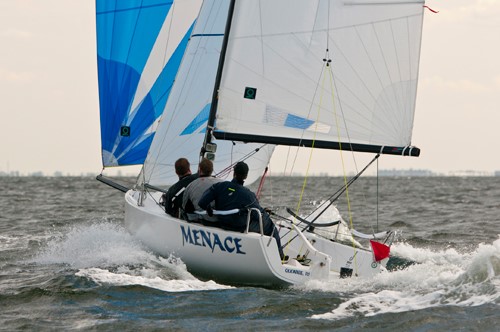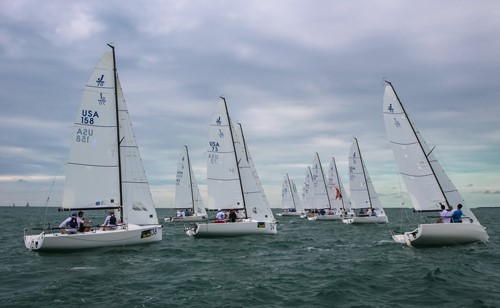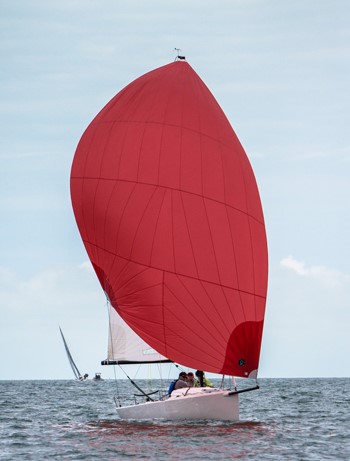J/70 experts Terry Flynn and Kerry Klingler shre their observations on sail design, crew weight, tuning, sail trim and more to help you master speed on your J/70.
First and foremost, it's important to understand how we arrived at the sail designs. As a sailmaker the J/70 is quite a challenge. With great success in the Melges 20s and similar classes, we had an excellent starting point. Taking into account the differences in rigs and mast bend, sheeting angles and class rules, we built and tested a few sets of sails. During our two-boat testing process, we photographed the sails from all angles to verify the sailing shapes and flying shapes were what we expected to see.
 Photo by Allen Clark, Photoboat.com.
Photo by Allen Clark, Photoboat.com.
Tweaks
With any one design class there are unknowns. The biggest unknown in the J/70 class became the crew weight. Crew weight is a balancing act: too much and you suffer in lighter winds and mainly downwind. Will the extra weight keep you from planing sooner? Will the lack of weight hurt upwind in the breeze? In the begining with certain rig settings, the sails excelled in the light to medium winds at the beginning of the week; were not pleased with the overall results in the higher winds. Again, the biggest variable was crew weights. Weights varied from 630 to 745 pounds.
To tweak our performance, we did some two-boat testing before the next big regatta and our list of tests included optimizing the crew weight, testing different rig tensions on the uppers and lowers including headstay lengths and crew placement for downwind. We got in a great day of testing with our training partner Richard Lehmann and other Quantum experts. It was nice to check our work and see what did and didn't work. During the regatta we talked about our rig settings, what we thought the wind was going to do during the day and in general bounce ideas and thoughts off each other. We also docked next to each other and went over rig tuning at the end of the day.
The J-70 has some unique qualities that have to be taken into account for racing. The first is the speed differential in the boats. If you tune and trim properly the boat is a lot faster. This is true upwind and downwind.
Upwind
Our tuning guide now has the rake set at 55.5”; this gives us a pretty nice feel in the boat even in the lighter wind ranges. Care should be exercised, as you need to have the right shroud lengths to carry this amount of rake. Marking the spreaders is critical for fast easy trimming of the jib.
 Photo by Keith Brash
Photo by Keith Brash
We worked together on the trim issue. We constantly checked on how tight the sail was. This tightness was from me sitting on the windward side looking at the leech through the window. It was easy to see the closeness of the leech in relationship to the spreader mark and adjust slightly. Also we used speed to help with trim, if we felt it was hard to get the boat up to speed a slight ease could make all the difference. Looking for more point we would sheet in slightly.
The boat is also very dingy like and requires constant trim on the mainsheet. Easing in the puffs and keeping the boat flat seems to be fast. Also trimming in the light wind and going for more pointing seems to work well. We think this is why a lot of the boats are sailing with four crew members. You can have one crew constantly working the main to get the most speed out of the boat.
Downwind (in marginal planning conditions)
This is the one area where the biggest gains can be made on the racecourse. The difference between planning speed and displacement sailing can be over four knots. The key we learned is the following: the boat likes flat water, keeping the bow up and pressure on the rig is vital. When sailing to leeward to other boats we always seemed too loose to the boats to windward of us. We seemed to be caught in their waves and could not adjust easily to get the boat through this added waves. When we sailed to windward of other boats, we were able to adjust to the pressure on the sails and the waves. The key is to not plow into a leading wave but to head up slightly and keep the boat on a plane. The other key was to have a crew locked on looking behind for puffs. Hook one puff, before your competition, and you could make up some big distances.
 Photo by Keith Brash
Photo by Keith Brash
Lessons Learned
- Keep trying more crew weight; over 700# seems to be the minimum.
- In-Hauler. Shorten the Jib clew blocks to as close to clew as you can get. This will make improve the lead so when you pull the windward sheet it pulls it in and not up and forward.
- How much In-Hauler? We had great results just outside the cabin top.
- Halyard tension. The halyard arrangement is easy to use so don’t be afraid to play and adjust to help with this to help shift gears in puffs. In 8 kts we found just little scallops between hanks was fast. I think our actual halyard adjustment line should be longer so it can be played when on the rail.
Get the latest J/70 tuning guide and quick tune chart here under the "Links & Resources" section.